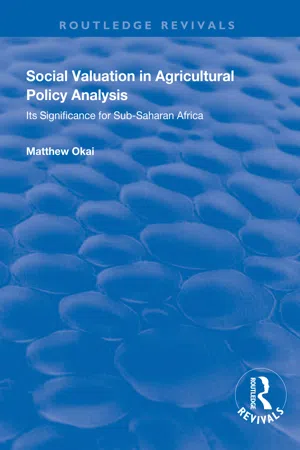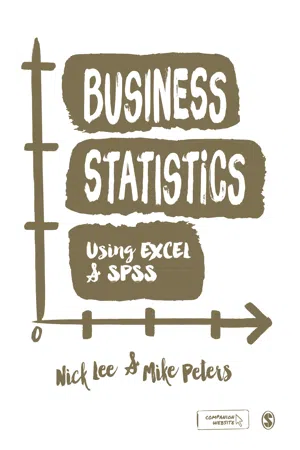Business
Quantitative Demand Analysis
Quantitative demand analysis involves using numerical data and statistical methods to understand and predict consumer demand for a product or service. It focuses on analyzing factors such as price elasticity, market trends, and consumer behavior to make informed decisions about pricing, production, and marketing strategies. This approach helps businesses to quantify and measure demand, enabling them to make data-driven decisions.
Written by Perlego with AI-assistance
Related key terms
Related key terms
1 of 4
Related key terms
1 of 3
3 Key excerpts on "Quantitative Demand Analysis"
- eBook - ePub
Social Valuation in Agricultural Policy Analysis
Its Significance for Sub-Saharan Africa
- Matthew Okai(Author)
- 2019(Publication Date)
- Routledge(Publisher)
41 ). The horizontal axis is the time in years, while the vertical axis is the tonnage of rice demanded. The projected dotted line is one possible way in which the market in future will behave. The analysis is usually concerned with explaining whether the projection represents a realistic amount of rice that will be consumed in future, represented by years 5 and 6 that lie in the future. The numbers −3, −2, −1, −0 beside lack coordinates for each combination of a year and the quantity of rice consumed each representing a year. The year 0 is the present time.In demand analysis it is recognized that the demand for a commodity is determined by the interaction of many factors apart from its price. The most important of these factors that affect a consumer’s demand include the prices of related goods, consumer’s income, consumer’s tastes and preferences, total population, range of goods available to the consumer, and consumer expectations. When all factors that affect the demand of a commodity are taken together, a demand relationship can be established in quantitative terms. This relationship can be expressed in a functional form as:Trends in consumption of riceFigure 40General market behaviour in response to price changesFigure 41whereX t= f(P x,P n, Y, N, R, E)Xtis the quantity of commodity X demanded; Pxis the price of X; Pnrepresents the prices of related goods; Y represents total consumers income and its distribution; T represents consumers’ tastes and preferences; N is the number of consumers under consideration (population); R represents the range of goods and services available to consumers; and E represents consumers’ expectations. The demand analysis centres around the estimation of the above relationships using various functional forms depending on the specific circumstances and issues under investigation. The most important three variables are: i) the price of the commodity (Px ); ii) the price of related goods (Pn ); iii) population (N) and consumer income (Y).Quantitative Demand Analysis is usually performed through correlation analysis and regression, a technique used in investigating the relationship or association between two variables. In the analysis there are usually two types of variables employed: endogenous and exogenous. An endogenous (dependent) variable, usually denoted as Y, is one whose values are explained by the exogenous (usually denoted by X) variables (independent variables). The exogenous variables are also known as explanatory variables. To investigate the degree to which the demand determinants influence endogenous variables one can apply the concept of elasticity and regression. - eBook - ePub
- Nick Lee, Mike Peters(Authors)
- 2015(Publication Date)
- SAGE Publications Ltd(Publisher)
One thing I did not expect was how important quantitative analysis skills would be in my degree. In fact, I was forced to study two quantitative modules in my first year – two ! Maths and Stats! You might be having the same issues. Then, as I specialized in marketing, I had to study yet more quantitative techniques. Not to put too fine a point on it, I struggled for quite a few years with numbers. I just never seemed to be able to get my head around all the concepts. While this was likely to be because I am just fundamentally lazy and had what I thought were better things to do, it may also have been partly because I didn’t see quite how business was not the ‘seat of the pants’ career I expected, but one where the smart and successful decisions are most often made based on the analysis of data. After all, I was quite keen on studying strategic decisions, or designing creative marketing campaigns, but I didn’t understand how those decisions depended on an earlier process of data analysis. In this section, I’m going to try to give a brief picture of how quantitative analysis is vital to almost all business careers, which may help you to understand the importance it has to your own success. In fact, now that I know multiple creative directors from advertising agencies, I realize that even what I thought was a completely non-numerical field is often heavily dependent on data analysis to make decisions. As I’ve already alluded to, the key way in which quantitative analysis is used in business is to help make decisions. In almost all cases, if you want to maximize your chances of making an effective decision, you need to base that decision on information. Different professions or situations need different types of information, but in almost all cases a large part of that information is numerical, either in the form of data which is specifically collected for the purpose (e.g. consumer satisfaction scores), or as part of the inherent nature of the profession (e.g - Bonita Kolb(Author)
- 2008(Publication Date)
- Routledge(Publisher)
The responses on these questionnaires will be counted and the results will be the number of participants that responded to each question by selecting a particular answer. These numbers can then be analysed by turning them into percentages or ratios. Everyone is familiar with research findings that state 62% of the audience is male or that people prefer purchasing their tickets online by a three to one majority.Simple quantitative analysis using only counting and basic math can describe both consumers and their behaviour. For example, a quantitative study can state that 22% of the audience for the opening performance was under the age of 30 years. Numbers can also state that 37% of the audience recalled seeing the advertisement for the opening night in the local newspaper. In addition math can be used to calculate the variation in the behaviour of members of a group.However more sophisticated quantitative analysis requires knowledge of statistics. While software programs will do the calculations that result in the statistics, the researcher will still need to understand how the statistics should be interpreted. These statistics are used to disprove or support the hypothesis that was stated when the research began. For example, analysing the research findings will allow an organization to state, ‘With 97% confidence over 50% of city residents prefer to have their tax dollars fund recycling.’The analysis of quantitative data only occurs after the research has been completed. After all there is no reason to analyse findings when only half of the forms that are expected to be returned are in. It would be a waste of effort since the exact same analysis will need to be completed once all the forms are available. However, once the analysis of findings does begin the numbers can be continually compared and contrasted for new meanings. For example, a survey on recycling habits of local residents can first examine how many people recycle. Later someone may ask the question if senior citizens recycle more than people in their twenties. The data can then be re-examined for an answer to this question.
Index pages curate the most relevant extracts from our library of academic textbooks. They’ve been created using an in-house natural language model (NLM), each adding context and meaning to key research topics.
Explore more topic indexes
Explore more topic indexes
1 of 6
Explore more topic indexes
1 of 4


